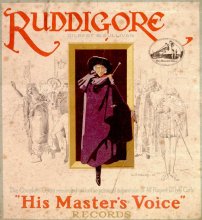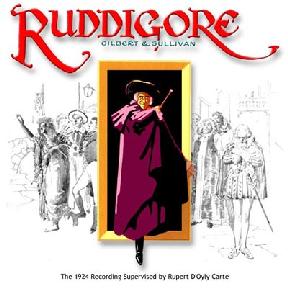The 1924 D'Oyly Carte Ruddigore
Chorus and Light Opera Orchestra
Recorded in London, |
|
 HMV Album Cover |
Of the fourteen G&S operas, only two were clear failures on their first nights: Ruddigore and The Grand Duke. Both completed their original runs and were never revived in Gilbert's or Sullivan's lifetimes. In 1920, however, Rupert D'Oyly Carte decided the time was finally right for a revival of Ruddigore. The notion of "bloody gore" and ghosts who come back to life was too shocking for prudish Victorian audiences, but Rupert judged (correctly) that twentieth century audiences would appreciate the opera's many strengths.
In the wake of the first-night failure, Gilbert and Sullivan had revised their opera heavily, shortening the second act and toning down most of the references to revived ghosts. Rupert D'Oyly Carte felt that further changes were needed, and he authorized his musical directors of the time, Harry Norris and Geoffrey Toye, to make whatever revisions they thought necessary to render the work stageworthy. Perhaps the most inspired revision was Toye's new overture, replacing Hamilton Clarke's original that was arguably the weakest of those Sullivan delegated to assistants. Less sensible was the replacement of the original Act II finale with a simple reprise of "Oh, happy the lily." The excision of Robin's "Henceforth all the crimes" and the Act II melodrama also apparently date from this round of revisions.
Since Ruddigore had been entirely out of the repertory since 1887, the audiences of the 1920 revival saw what was, to all intents and purposes, essentially a brand new opera. The work met with enormous success and was seldom out of the repertory thereafter. This recording, made just a few years after the revival and with several of the same singers, captures much of its excitement. Unlike most of the other operas, no Ruddigore performing tradition survived the nineteenth century. The tradition we know today is the one most of these singers helped to create.
In this recording, Oldham, Sheffield, Fancourt and Lewis recreate their roles from the 1920 revival. Elsie Griffin did not create Rose for the revival but was with the Company at the time. Eileen Sharp joined the Company a year later. Henry Lytton, who played Robin in the revival, was evidently judged too old to record the part, and so was replaced by George Baker, who was a fixture on most of these early recordings. Edward Halland, who played Old Adam, was not with D'Oyly Carte but sang chorus and small parts on several of the early sets.
The "improvements" to the score that debuted in the 1920 revival have been much criticized, but this recording shows that they didn't happen all at once. Several instrumental passages are heard here in different versions than heard in later years, leading one to conclude that nips and tucks in the score continued for years afterwards. The set includes "The battle's roar is over," although contemporary reviews reveal that it was omitted in stage performances of the time. (It is omitted on the 1931 recording.)
Lastly, this recording is known for a bit of trivia: the inclusion of Robin's short soliloquy before the entry of the ghosts in Act II. It is the only patch of dialogue on a G&S recording until several of the D'Oyly Carte stereo recordings of the late fifties and early sixties were issued with dialogue complete.
For the quality of the cast presented and its proximity to the first revival, this is one of the most important recordings of the acoustical era. It was re-issued on LP by Pearl Records. It is now available on CD from both Chris Webster Sounds on CD and Jim Lockwood 78s2cd.
This is what Webster had to say about his release:
There are not enough superlatives in the world (well, in my vocabulary anyway) to adequately describe the performances on this recording. For characterisation and sheer theatrical magnetism, this recording of Ruddigore has no equal, but this does not detract in any way to the musicianship of these performers under the first-rate musical direction of one of the D'Oyly Carte Opera Company's finest conductors, Harry Norris. As was usual at this stage, George Baker took on the patter role (superbly, I may add), although more surprisingly the small role (on record) of Old Adam is also played by a non-Carter (Edward Halland), but the remainder of the cast is pure magic vintage D'Oyly Carte — Leo Sheffield (one of the greatest performers of G&S ever, in one of his greatest recorded roles, IMO), Darrell Fancourt, Derek Oldham, Bertha Lewis, Elsie Griffin and Eileen Sharp. There are many terrific performances in this recording but I must single out Fancourt's first recording of "When the night wind howls" (as heard in this set) which ranks as one of the finest single recordings of any G&S piece.
For this issue, I have upgraded my usual accompanying booklet from eight pages to twelve by including an additional four pages which are packed with wonderful photographs and illustrations connected with the stage production upon which this recording is based. Of course all the usual features of my booklets appear here too — detailed notes on the recorded performances, the history of the recording, a schedule of the recording sessions with full recording details especially researched for this CD issue using EMIs archive material from the National Sound Archive, artist biographies and beautifully restored contemporary artwork. As usual with these acclaimed Sounds on CD issues, the 78s have been edited for perfect musical continuity while at the same time offering frequent track cue points for maximum musical accessibility within the opera (36 in this instance).
Every G&S enthusiast should own a copy of this recording which may be looked at as being a companion, as well as a fine precursor, to the equally legendary 1924/5 recording of Princess Ida.
Review from The Gramophone, 1927
| Date | Label | Format | Number | Comments |
|---|---|---|---|---|
| 1924 | HMV | 78rpm | D878/86 | |
| 1970s | Pearl | LP | GEM 133/4 | |
| 1999 | Opera Classics | CD-ROM | AE205 | CD-ROM titled "From Which We Came," including numerous early recordings of opera. The G&S content (which is only a fraction of what's on the disc) includes the HMV acoustical recordings of The Mikado, H.M.S Pinafore, Princess Ida, and Ruddigore. Note that this CD can be played only on a computer, not on a conventional audio player. |
| 2000 | Sounds on CD | CD | VGS220 | |
| 2000 | 78s 2 CD | CD | GS12 |
| Side Nbr | Matrix Number | Selection | Rec. Date |
|---|---|---|---|
| 1 | Cc4624-2 |
|
22 May 24 |
| 2 | Cc4627-4 |
|
30 Jun 24 |
| 3 | Cc4626-2 |
|
22 May 24 |
| 4 | Cc4744-1 |
|
19 Jun 24 |
| 5 | Cc4629-1 |
|
22 May 24 |
| 6 | Cc4745-2 |
|
19 Jun 24 |
| 7 | Cc4747-2 |
|
19 Jun 24 |
| 8 | Cc4694-2 |
|
5 Jun 24 |
| 9 | Cc4748-3 |
|
19 Jun 24 |
| 10 | Cc4628-2 |
|
22 May 24 |
| 11 | Cc4625-3 |
|
30 Jun 24 |
| 12 | Cc4695-1 |
|
5 Jun 24 |
| 13 | Cc4696-1 |
|
5 Jun 24 |
| 14 | Cc4746-2 |
|
19 Jun 24 |
| 15 | Cc4698-4 |
|
30 Jun 24 |
| 16 | Cc4699-2 |
|
5 Jun 24 |
| 17 | Cc4749-3 |
|
19 Jun 24 |
| 18 | Cc4697-1 |
|
5 Jun 24 |
Notes:
- Zorah's solo in the opening chorus is omitted. Elsie Griffin sings Zorah's line in the Act I finale.
- Sources disagree on whether Harry Norris or George W. Byng conducted this set. Francissays it's Norris, and as he has had access to the HMV daybooks, I am assuming he is correct.
- Sides 9, 17 & 18 were included on Pearl's Art of the Savoyard, Volume 1.
- Sides 2, 6 & 18 were included on Arabesque's LP reissue of the 1931 Ruddigore.
| Result | Matrix Number | Selection |
|---|---|---|
| Session One, 22 May 1924 | ||
| Issued s.1 | Cc4624-1 Cc4624-2 |
|
| Rejected | Cc4625-1 Cc4625-2 |
|
| Issued s.3 | Cc4626-1 Cc4626-2 |
|
| Rejected | Cc4627-1 Cc4627-2 |
|
| Issued s.10 | Cc4628-1 Cc4628-2 |
|
| Issued s.5 | Cc4629-1 |
|
| Session Two, 5 June 1924 | ||
| Issued s.8 | Cc4694-1 Cc4694-2 |
|
| Issued s.12 | Cc4695-1 |
|
| Issued s.13 | Cc4696-1 |
|
| Issued s.18 | Cc4697-1 |
|
| Rejected | Cc4698-1 Cc4698-2 |
|
| Issued s.16 | Cc4699-1 Cc4699-2 |
|
| Session Three, 19 June 1924 | ||
| Issued s.4 | Cc4744-1 |
|
| Issued s.6 | Cc4745-1 Cc4745-2 |
|
| Issued s.14 | Cc4746-1 Cc4746-2 |
|
| Issued s.7 | Cc4747-1 Cc4747-2 |
|
| Issued s.9 | Cc4748-1 Cc4748-2 Cc4748-3 |
|
| Issued s.17 | Cc4749-1 Cc4749-2 Cc4749-3 |
|
| Session Four, 30 June 1924 | ||
| Issued s.11 | Cc4625-3 |
|
| Issued s.2 | Cc4627-3 Cc4627-4 |
|
| Issued s.15 | Cc4698-3 Cc4698-4 |
|
Notes:
- The bulk of the recording was made at three sessions, on 22 May, and 5 & 19 June 1924. A session on 30 June 1924 was scheduled to redo three sides that had not been recorded acceptably at the earlier sessions.
- Unlike some of the earlier acoustical sets, there are no known sides for which multiple matrices were issued. In the table above, rejected matrix numbers are shown in italics. If no acceptable take for a given side was recorded at a given session, then the Result column contains the word Rejected, and the entire row is italicized. Otherwise, the Result column indicates the side number of the issued take (which is the last matrix in each such case), and unissued matrices are shown in italics.

